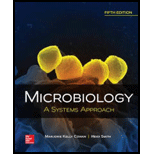
Microbiology: A Systems Approach
5th Edition
ISBN: 9781259706615
Author: Marjorie Kelly Cowan Professor
Publisher: McGraw-Hill Education
expand_more
expand_more
format_list_bulleted
Concept explainers
Question
Chapter 8.3, Problem 16AYP
Summary Introduction
To describe:
The catabolism of non-carbohydrate compounds.
Introduction:
Expert Solution & Answer
Want to see the full answer?
Check out a sample textbook solution
Students have asked these similar questions
The Sentinel Cell: Nature’s Answer to Cancer?
Molecular Biology Question
You are working to characterize a novel protein in mice. Analysis shows that high levels of the primary transcript that codes for this protein are found in tissue from the brain, muscle, liver, and pancreas. However, an antibody that recognizes the C-terminal portion of the protein indicates that the protein is present in brain, muscle, and liver, but not in the pancreas. What is the most likely explanation for this result?
Molecular Biology
Explain/discuss how “slow stop” and “quick/fast stop” mutants wereused to identify different protein involved in DNA replication in E. coli.
Chapter 8 Solutions
Microbiology: A Systems Approach
Ch. 8.1 - Describe the relationship among metabolism,...Ch. 8.1 - Fully discuss the structure and function of...Ch. 8.1 - Differentiate between an apoenzyme and a...Ch. 8.1 - Differentiate between an endoenzyme and an...Ch. 8.1 - Diagram the four major patterns of metabolism.Ch. 8.1 - Describe how enzymes are controlled.Ch. 8.2 - Name the chemical in which energy is stored in...Ch. 8.2 - Create a general diagram of a redox reaction.Ch. 8.2 - Identify electron carriers used by cells.Ch. 8.3 - List three basic catabolic pathways and the...
Ch. 8.3 - Construct a paragraph summarizing glycolysis.Ch. 8.3 - Describe the Krebs cycle and compare the process...Ch. 8.3 - Discuss the significance of the electron transport...Ch. 8.3 - State two ways in which anaerobic respiration...Ch. 8.3 - Summarize the steps of microbial fermentation and...Ch. 8.3 - Prob. 16AYPCh. 8.4 - Prob. 17AYPCh. 8.4 - Define amphibolism.Ch. 8.5 - Summarize the overall process of photosynthesis in...Ch. 8.5 - Discuss the relationship between light-dependent...Ch. 8.5 - Explain the role of the Calvin cycle in the...Ch. 8 - Prob. 1MCQCh. 8 - An enzyme a. becomes part of the final products....Ch. 8 - An apoenzyme is where the ____ is located. a....Ch. 8 - Many coenzymes are a. metals. b. vitamins. c....Ch. 8 - Prob. 5MCQCh. 8 - Energy is carried from catabolic to anabolic...Ch. 8 - A product or products of glycolysis is/are a. ATP....Ch. 8 - Prob. 8MCQCh. 8 - Complete oxidation of glucose in aerobic...Ch. 8 - ATP synthase complexes can generate ______ ATP(s)...Ch. 8 - True-False Questions. If the statement is true,...Ch. 8 - An enzyme lowers the activation energy required...Ch. 8 - One cycle of fermentation yields more energy than...Ch. 8 - Energy in biological systems is primarily...Ch. 8 - Exoenzymes are produced outside the cell.Ch. 8 - Prob. 1CTQCh. 8 - Prob. 2CTQCh. 8 - Compare and contrast the processes of...Ch. 8 - Draw a bacterial cell and a eukaryotic cell side...Ch. 8 - Provide evidence in support of or refuting the...Ch. 8 - From chapter 4, figure 4.16. On the enlarged...Ch. 8 - Using the words that follow, please create a...
Knowledge Booster
Learn more about
Need a deep-dive on the concept behind this application? Look no further. Learn more about this topic, biology and related others by exploring similar questions and additional content below.Similar questions
- Molecular Biology Question A gene that codes for a protein was removed from a eukaryotic cell and inserted into a prokaryotic cell. Although the gene was successfully transcribed and translated, it produced a different protein than it produced in the eukaryotic cell. What is the most likely explanation?arrow_forwardMolecular Biology LIST three characteristics of origins of replicationarrow_forwardMolecular Biology Question Please help. Thank you For E coli DNA polymerase III, give the structure and function of the b-clamp sub-complex. Describe how the structure of this sub-complex is important for it’s function.arrow_forward
- Molecular Biology LIST three characteristics of DNA Polymerasesarrow_forwardMolecular Biology RNA polymerase core enzyme structure contains what subunits? To form holo enzyme, sigma factor is added to core. What is the name of the structure formed? Give the detailed structure of sigma factor and the function of eachdomain. Please help. Thank youarrow_forwardMolecular Biology You have a single bacterial cell whose DNA is labelled with radioactiveC14. After 5 rounds of cell division, how may cells will contain radioactive DNA? Please help. Thank youarrow_forward
- 1. Explain the structure and properties of atoms and chemical bonds (especially how they relate to DNA and proteins). Also add some pictures.arrow_forward1. In the Sentinel Cell DNA integrity is preserved through nanoscopic helicase-coordinated repair, while lipids in the membrane are fortified to resist environmental mutagens. also provide pictures for this question.arrow_forwardExplain the structure and properties of atoms and chemical bonds (especially how they relate to DNA and proteins). Also add some pictures.arrow_forward
- In the Sentinel Cell DNA integrity is preserved through nanoscopic helicase-coordinated repair, while lipids in the membrane are fortified to resist environmental mutagens. also provide pictures for this question.arrow_forward1. Explain how genetic information is stored, copied, transferred, and expressed. Also add some pictures for this question.arrow_forward!. Describe biological macromolecules (DNA, RNA, proteins, lipids, etc.) and how they function in the cell. also provide some images for this question.arrow_forward
arrow_back_ios
SEE MORE QUESTIONS
arrow_forward_ios
Recommended textbooks for you
 Biology Today and Tomorrow without Physiology (Mi...BiologyISBN:9781305117396Author:Cecie Starr, Christine Evers, Lisa StarrPublisher:Cengage Learning
Biology Today and Tomorrow without Physiology (Mi...BiologyISBN:9781305117396Author:Cecie Starr, Christine Evers, Lisa StarrPublisher:Cengage Learning Health Safety And Nutrition F/Young ChildHealth & NutritionISBN:9781305144767Author:MAROTZPublisher:Cengage
Health Safety And Nutrition F/Young ChildHealth & NutritionISBN:9781305144767Author:MAROTZPublisher:Cengage

Biology Today and Tomorrow without Physiology (Mi...
Biology
ISBN:9781305117396
Author:Cecie Starr, Christine Evers, Lisa Starr
Publisher:Cengage Learning





Health Safety And Nutrition F/Young Child
Health & Nutrition
ISBN:9781305144767
Author:MAROTZ
Publisher:Cengage